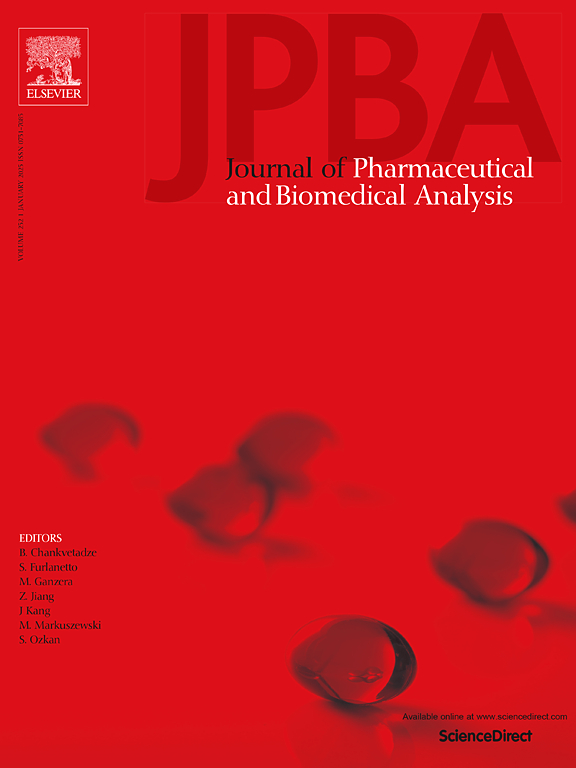多维指纹图谱和多成分定量法综合评价胡里茶六味丸的质量
IF 3.1
3区 医学
Q2 CHEMISTRY, ANALYTICAL
Journal of pharmaceutical and biomedical analysis
Pub Date : 2025-04-25
DOI:10.1016/j.jpba.2025.116925
引用次数: 0
摘要
近年来,中药在世界范围内的应用逐渐增多,对中药质量控制的研究也变得越来越重要。蒙药作为中医的一个分支,其成分复杂,缺乏对整体质量的研究。因此,本文以胡里茶六味丸(HLP)为例,建立了高效液相色谱法(HPLC)、差示扫描量热法(DSC)和电化学法(EC)三种指纹图谱,并采用综合比定量指纹图谱法(CRQFM)对三种指纹图谱的质量进行了评价。为保证定量分析的准确性,采用双波长吸收系数比(DWACR)对指纹峰的纯度进行验证。采用单线性多标记法(MAML)对没食子酸(GA)、绿原酸(CA)、羟基红花黄A (HSYA)和鞣花酸(EA)进行定量分析。基于EC氧化还原特性,建立了HPLC和DSC两种指纹图谱与EC活性的药效关系。结果表明,经过CRQFM评价,16批样品被划分为不同的质量等级。随后,采用等称重法对评价结果进行综合,得到16批样品的质量等级为1 ~ 3级。指纹图谱效价关系表明,GA、CA、EA等超过半数的指纹图谱峰具有良好的抗氧化活性。本文建立了有效的hplc质量控制方法,为其他中药的质量评价提供了新的思路。本文章由计算机程序翻译,如有差异,请以英文原文为准。
Comprehensive quality evaluation of Huricha Liuwei Pills using multidimensional fingerprinting and multicomponent quantification
In recent years, the application of traditional Chinese medicine (TCM) has gradually increased in the world, the study of quality control has become more and more important. As a branch of TCM, Mongolian medicine has complex compositions and lacks research on the overall quality. Therefore, in this paper, three fingerprints, high performance liquid chromatography (HPLC), differential scanning calorimetry (DSC) and electrochemical (EC), were established using Huricha Liuwei pills (HLP) as an example, and the quality of the three fingerprints was evaluated by the comprehensive ratio quantitative fingerprint method (CRQFM). To ensure the accuracy of the quantitative analysis, the purity of the fingerprint peaks was verified using the dual-wavelength absorption coefficient ratio (DWACR). And four components were quantified by the multi-markers assay by monolinear method (MAML): gallic acid (GA), chlorogenic acid (CA), hydroxysafflor yellow A (HSYA) and ellagic acid (EA). Based on the EC redox characteristics, the fingerprint efficacy relationship between two fingerprints (HPLC and DSC) and EC activity was established. The results showed that after CRQFM evaluation, 16 batches of samples were categorized into different quality grades. Subsequently, the evaluation results were integrated using the equal weighing method, and the 16 batches of samples had quality grades ranging from 1 to 3. The fingerprint efficacy relationship indicated that more than half of the fingerprint peaks showed good antioxidant activity, including GA, CA and EA. This paper established an effective quality control method for HLP and provided new ideas for the quality evaluation of other TCM.
求助全文
通过发布文献求助,成功后即可免费获取论文全文。
去求助
来源期刊
CiteScore
6.70
自引率
5.90%
发文量
588
审稿时长
37 days
期刊介绍:
This journal is an international medium directed towards the needs of academic, clinical, government and industrial analysis by publishing original research reports and critical reviews on pharmaceutical and biomedical analysis. It covers the interdisciplinary aspects of analysis in the pharmaceutical, biomedical and clinical sciences, including developments in analytical methodology, instrumentation, computation and interpretation. Submissions on novel applications focusing on drug purity and stability studies, pharmacokinetics, therapeutic monitoring, metabolic profiling; drug-related aspects of analytical biochemistry and forensic toxicology; quality assurance in the pharmaceutical industry are also welcome.
Studies from areas of well established and poorly selective methods, such as UV-VIS spectrophotometry (including derivative and multi-wavelength measurements), basic electroanalytical (potentiometric, polarographic and voltammetric) methods, fluorimetry, flow-injection analysis, etc. are accepted for publication in exceptional cases only, if a unique and substantial advantage over presently known systems is demonstrated. The same applies to the assay of simple drug formulations by any kind of methods and the determination of drugs in biological samples based merely on spiked samples. Drug purity/stability studies should contain information on the structure elucidation of the impurities/degradants.

 求助内容:
求助内容: 应助结果提醒方式:
应助结果提醒方式:


